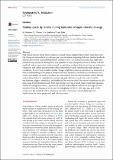Files in this item
Carbon cycle dynamics during episodes of rapid climate change
Item metadata
| dc.contributor.author | Meissner, K J | |
| dc.contributor.author | Brook, E | |
| dc.contributor.author | Finkelstein, S A | |
| dc.contributor.author | Rae, J | |
| dc.date.accessioned | 2021-04-01T15:30:06Z | |
| dc.date.available | 2021-04-01T15:30:06Z | |
| dc.date.issued | 2021-03-23 | |
| dc.identifier | 273498839 | |
| dc.identifier | 6e9a93ee-f7a0-4488-9765-d5f61e193b74 | |
| dc.identifier | 85103440856 | |
| dc.identifier | 000631856800001 | |
| dc.identifier.citation | Meissner , K J , Brook , E , Finkelstein , S A & Rae , J 2021 , ' Carbon cycle dynamics during episodes of rapid climate change ' , Environmental Research Letters , vol. 16 , no. 4 , 040201 . https://doi.org/10.1088/1748-9326/abeade | en |
| dc.identifier.issn | 1748-9326 | |
| dc.identifier.other | Jisc: 257b37ea2dea41cabd20afc9e9110a6b | |
| dc.identifier.other | publisher-id: erlabeade | |
| dc.identifier.other | manuscript: abeade | |
| dc.identifier.other | other: erl-110785 | |
| dc.identifier.other | ORCID: /0000-0003-3904-2526/work/91340955 | |
| dc.identifier.uri | https://hdl.handle.net/10023/21758 | |
| dc.description.abstract | Past climate records reveal many instances of rapid climate change that are often coincident with fast changes in atmospheric greenhouse gas concentrations, suggesting links and positive feedbacks between the carbon cycle and the physical climate system. The carbon reservoirs that might have played an important role during these past episodes of rapid change include near-surface soil and peatland carbon, permafrost, carbon stored in vegetation, methane hydrates in deep-sea sediments, volcanism, and carbon stored in parts of the ocean that are easily ventilated through changes in circulation. To determine whether similar changes might lie in store in our future, we must gain a better understanding of the physics, biogeochemistry, dynamics, and feedbacks involved in such events. Specifically, we need to ascertain the main natural sources of atmospheric carbon dioxide and methane linked to rapid climate events in the paleoclimate record, and understand the mechanisms, triggers, thresholds, and feedbacks that were involved. Our review contributes to this focus issue by synthesizing results from nine studies covering a broad range of past time episodes. Studies are categorized into (a) episodes of massive carbon release millions of years ago; (b) the transition from the last glacial to the current interglacial 19 000–11 000 years ago; and (c) the current era. We conclude with a discussion on major remaining research challenges and implications for future projections and risk assessment. | |
| dc.format.extent | 8 | |
| dc.format.extent | 808230 | |
| dc.language.iso | eng | |
| dc.relation.ispartof | Environmental Research Letters | en |
| dc.subject | GE Environmental Sciences | en |
| dc.subject | SDG 13 - Climate Action | en |
| dc.subject.lcc | GE | en |
| dc.title | Carbon cycle dynamics during episodes of rapid climate change | en |
| dc.type | Journal item | en |
| dc.contributor.sponsor | European Research Council | en |
| dc.contributor.institution | University of St Andrews. Earth and Environmental Sciences | en |
| dc.contributor.institution | University of St Andrews. School of Earth & Environmental Sciences | en |
| dc.contributor.institution | University of St Andrews. St Andrews Isotope Geochemistry | en |
| dc.identifier.doi | 10.1088/1748-9326/abeade | |
| dc.description.status | Peer reviewed | en |
| dc.identifier.grantnumber | 805246 | en |
This item appears in the following Collection(s)
Items in the St Andrews Research Repository are protected by copyright, with all rights reserved, unless otherwise indicated.

